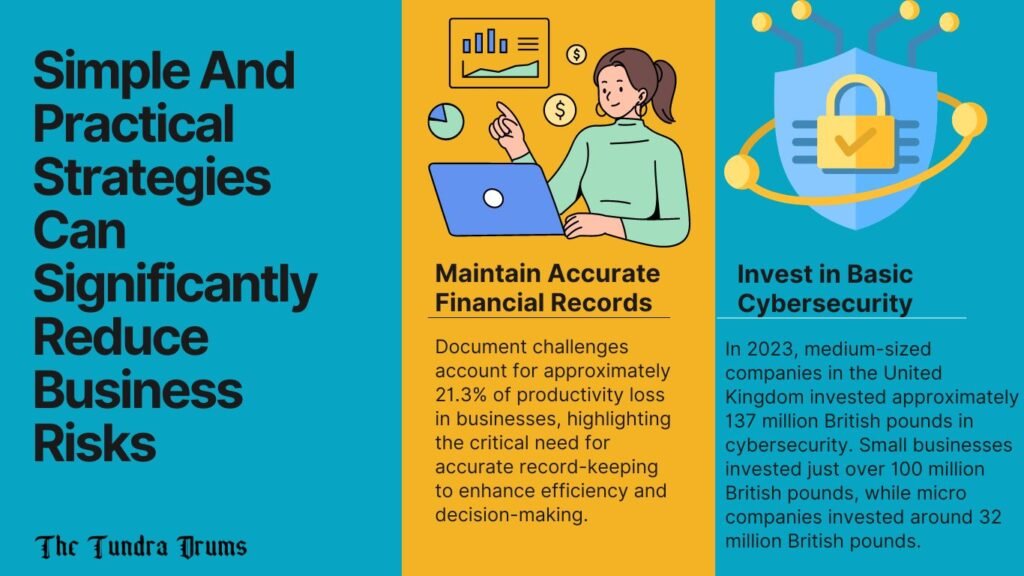Risk management is crucial in business as it helps identify, assess, and mitigate potential threats that could negatively impact operations, finances, or reputation. By implementing effective risk management strategies, businesses can protect themselves from unforeseen events, ensuring long-term stability and success.
Simple and practical approaches, such as diversifying investments, maintaining robust internal controls, and regularly reviewing and updating risk management plans, can significantly reduce risks and enhance a company’s resilience in a competitive environment. These strategies enable businesses to proactively address potential issues, minimizing losses and maximizing opportunities for growth.
Types Of Risks That Businesses Typically Face

Here are the key types of risks:
- Financial Risk: This involves the potential for financial loss due to factors such as market fluctuations, credit risks, liquidity issues, or changes in interest rates. Financial risks can affect a company’s profitability, cash flow, and overall financial stability.
- Operational Risk: These are risks related to the day-to-day operations of a business. They can arise from internal failures such as system breakdowns, human errors, or process inefficiencies, as well as external events like natural disasters or supply chain disruptions.
- Legal Risk: This type of risk arises from potential legal actions or regulatory changes that could affect a business. It includes the risk of lawsuits, fines, penalties, or compliance failures that could result in financial loss or damage to the business.
- Market Risk: Market risk is associated with changes in market conditions, such as fluctuations in demand, competition, or economic downturns. These risks can affect a company’s sales, pricing strategies, and overall market position.
- Reputational Risk: Reputational risk involves the potential damage to a company’s reputation, which can result from negative public perception, scandals, or poor customer experiences. Reputational damage can lead to loss of customers, reduced sales, and long-term harm to the brand.
Simple And Practical Strategies Can Significantly Reduce Business Risks

1- Maintain Accurate Financial Records
Keeping accurate financial records is the foundation of sound business management. It allows you to monitor your cash flow, track expenses, manage debts, and make informed financial decisions. Proper record-keeping can also help detect any discrepancies early, reducing the risk of fraud and ensuring that your business stays compliant with tax regulations.
How to Implement:
- Use Accounting Software: Invest in reliable accounting software like QuickBooks, Xero, or FreshBooks. These tools automate many aspects of financial management, reducing human error.
- Regular Financial Reviews: Schedule monthly reviews of your financial statements, such as income statements, balance sheets, and cash flow statements. This helps you stay on top of your financial health.
- Bank Reconciliation: Regularly reconcile your bank statements with your internal records to ensure all transactions are accounted for and to catch any errors or fraudulent activities early.
2- Diversify Revenue Streams
Relying on a single source of income makes your business vulnerable to market fluctuations. If that income stream dries up due to economic changes, customer loss, or competition, your business could face significant financial strain. Diversifying revenue sources spreads the risk and provides a safety net.
How to Implement:
- Explore New Markets: Identify and target new customer segments or geographic regions that might be interested in your products or services.
- Develop New Products or Services: Innovate by adding complementary products or services that align with your current offerings. For instance, if you run a café, you could start selling packaged coffee beans.
- Passive Income: Consider avenues like affiliate marketing, subscription models, or digital products that can generate additional income with minimal ongoing effort.
3- Invest in Basic Cybersecurity
Cybersecurity threats, such as data breaches and ransomware attacks, can have severe consequences, including financial losses, legal penalties, and damage to your business’s reputation. Even small businesses are targets, so it’s essential to implement basic cybersecurity measures.
How to Implement:
- Use Strong Passwords: Ensure that all employees use complex, unique passwords for business accounts and change them regularly. Implement two-factor authentication where possible.
- Install Antivirus Software: Use reputable antivirus and anti-malware software to protect your business devices from malicious software.
- System Updates: Regularly update your software, operating systems, and security patches to protect against the latest threats.
- Data Backup: Frequently back up your data to a secure location, such as cloud storage or an external hard drive, to ensure that you can recover it in case of a cyber incident.
4- Secure Appropriate Insurance
Business insurance protects your company from financial losses due to unforeseen events, such as accidents, lawsuits, natural disasters, or theft. Having the right coverage can mean the difference between recovery and closure in a crisis.
How to Implement:
- Identify Risks: Assess your business’s specific risks, such as property damage, liability, or cyber threats, and determine the types of insurance you need.
- Purchase Insurance: Obtain insurance policies that cover your identified risks. Common types include general liability, property insurance, workers’ compensation, and cyber liability insurance.
- Review and Update Policies: Regularly review your insurance coverage to ensure it matches your current business needs. Adjust your policies as your business grows or changes.
5- Establish Clear Contracts
Clear and well-drafted contracts prevent misunderstandings and disputes with clients, suppliers, employees, and partners. They set clear expectations, define roles and responsibilities, and provide legal protection if disagreements arise.
How to Implement:
- Use Standard Templates: Develop standard contract templates for common agreements, such as service contracts, supplier agreements, and employment contracts. These should be tailored to your business’s needs.
- Define Terms Clearly: Ensure that all contract terms, including payment schedules, deliverables, and deadlines, are clearly defined and understood by all parties.
- Legal Review: Have your contracts reviewed by a legal professional to ensure they are enforceable and comply with relevant laws and regulations.
6- Train Employees Regularly
Well-trained employees are less likely to make costly mistakes that can lead to business risks. Training also improves productivity, ensures compliance with regulations, and enhances overall job satisfaction, reducing turnover.
How to Implement:
- Job-Specific Training: Provide employees with training that is specific to their roles, ensuring they understand their responsibilities and how to perform tasks efficiently and safely.
- Safety Training: Implement regular safety training sessions, especially if your business involves physical labor or operates in a hazardous environment. This helps prevent workplace accidents and injuries.
- Compliance Training: Offer training on compliance with industry regulations, data protection laws, and company policies. This helps avoid legal issues and fines.
7- Develop a Simple Business Continuity Plan
A business continuity plan (BCP) prepares your company to handle disruptions, such as natural disasters, power outages, or economic downturns. Having a BCP in place ensures that your business can continue operating or quickly resume operations after an interruption.
How to Implement:
- Identify Key Functions: Determine which business functions are critical to your operations and what resources (e.g., personnel, technology) are needed to keep them running.
- Create a Response Plan: Develop a step-by-step plan for responding to various types of disruptions. This should include communication strategies, backup plans for key functions, and roles and responsibilities for employees.
- Test and Review: Regularly test your business continuity plan through drills or simulations, and review it periodically to ensure it remains relevant and effective.
8- Stay Compliant with Regulations
Non-compliance with laws and regulations can lead to fines, legal action, and reputational damage. Ensuring compliance helps you avoid these risks and maintain a good standing in your industry.
How to Implement:
- Stay Informed: Regularly research and stay updated on laws and regulations that affect your business. This might include industry-specific regulations, tax laws, labor laws, and data protection regulations.
- Compliance Procedures: Establish and document procedures for compliance in key areas such as health and safety, data protection, and employment law. Ensure that employees are trained on these procedures.
- Legal Consultation: Consult with legal professionals to review your business practices and ensure they comply with all applicable laws. This can be particularly important when expanding into new markets or launching new products.
9- Build Strong Relationships with Clients and Suppliers
Strong, positive relationships with clients and suppliers can reduce the risk of disputes, ensure timely delivery of goods and services, and create a reliable support network for your business. Trust and communication are key to these relationships.
How to Implement:
- Open Communication: Maintain regular and open communication with clients and suppliers. Address any concerns or issues promptly to prevent them from escalating.
- Honor Commitments: Always deliver on your promises, whether it’s meeting deadlines, providing quality products, or making timely payments. This builds trust and reliability.
- Resolve Conflicts Amicably: When conflicts arise, work towards amicable solutions that satisfy both parties. This can often be achieved through negotiation or mediation.
10- Monitor Market Trends
Understanding market trends helps you anticipate changes in customer preferences, economic conditions, and technological advancements. Staying ahead of these trends allows you to adapt your business strategy and avoid being caught off guard.
How to Implement:
- Industry Research: Regularly read industry reports, attend conferences, and participate in professional networks to stay informed about market trends.
- Customer Feedback: Collect and analyze customer feedback to identify emerging needs and preferences. Use this information to adjust your products or services accordingly.
- Flexible Strategy: Maintain a flexible business strategy that allows you to pivot quickly in response to market changes. This might involve updating your marketing approach, revising pricing, or exploring new product lines.
The Bottom Line
Managing business risks doesn’t have to be a complex or overwhelming task. By implementing simple and practical strategies—such as maintaining accurate financial records, diversifying revenue streams, investing in basic cybersecurity, securing appropriate insurance, and ensuring compliance with regulations—business owners can significantly reduce the potential threats that could impact their operations. These steps not only protect the business from unforeseen challenges but also create a solid foundation for growth and sustainability. By being proactive and consistently monitoring both internal practices and external market trends, business owners can navigate risks with confidence, ensuring their company remains resilient and competitive in an ever-changing environment.











